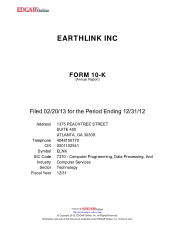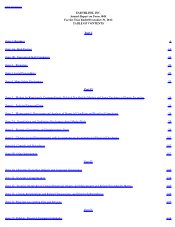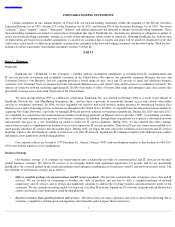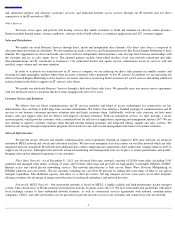Earthlink 2012 Annual Report Download - page 10
Download and view the complete annual report
Please find page 10 of the 2012 Earthlink annual report below. You can navigate through the pages in the report by either clicking on the pages listed below, or by using the keyword search tool below to find specific information within the annual report.
Table of Contents
Colocation Facilities - With co-
located communications equipment within the central offices of ILECs and alternative access providers
in various markets in the United States, we offer remote facilities-
based local and long distance services in markets by using our switches in
other locations as hosts. Using our fiber optic network and leased facilities to connect our remote equipment to our switches, colocation provides
cost-efficient access to last mile facilities to connect to customers.
Switch Facilities - Our array of switch facilities send voice and data traffic domestically and internationally through balanced and cost-
effective routing. Services are also offered on Metaswitch's MetaSphere MTAS (Multimedia Telephony Application Server) providing an
innovative portfolio of hosted and managed business-
class communications solutions such as nationwide hosted PBX and SIP trunking services.
Metaswitch's voice portal capabilities are also integrated into customer portals, offering our clients easy access to a ubiquitous, cross-
platform,
unified messaging, call control and self-service interface enabling them to access directly and upgrade their entire communications experience.
IT Services -
We are expanding our IT Services footprint, along with launching a next generation cloud hosting platform. The
enhancement of our existing data center in Rochester, N.Y., addition of four new data centers and our next-generation cloud high-
availability
architecture will allow us to offer state-of-the-
art integrated computing and storage platforms designed to support current and future demands of
our IT services products.
Network Management/Monitoring -
Our network infrastructure is supported by two geographically diverse Network Operations Centers
("NOCs") in Burlington, Massachusetts and Anniston, Alabama. These two centers operate 24 by 7, providing proactive network surveillance,
incident management, and planned maintenance activities for all Transport, Data, and Switching infrastructure. The two centers use a
consolidated suite of network surveillance tools that allows shared distribution of alarms and alerts. The geographic diversity of the NOCs
enables a robust disaster recovery/business continuity plan. In the event one NOC is unable to operate; functions are designed to transfer over to
the other fully redundant center.
Competition
The communications industry is highly competitive, and we expect this competition to intensify. These markets are rapidly changing
due to industry consolidation, an evolving regulatory environment and the emergence of new technologies. We compete directly or indirectly
with ILECs, such as AT&T, Inc., CenturyLink, Inc. and Verizon Communications Inc.; CLECs, such as Level 3 Communications Inc.,
MegaPath, Inc., Windstream Corporation and XO Communications; interexchange carriers, such as Sprint Nextel Corporation; wireless and
satellite service providers; cable service providers, such as Charter Communications, Inc., Comcast Corporation, Cox Communications, Inc. and
Time Warner Cable; and stand-
alone VoIP providers. We experience significant pricing and product competition from AT&T and other
incumbents that are the dominant providers of telecommunications services in our markets. We have reduced, and may be required to further
reduce, some or all of the prices we charge for our retail local, long distance and data services.
The IT services industry is also highly competitive. It is highly fragmented and evolving, with competitors ranging in size from small,
local independent firms to very large telecommunications companies, hardware manufacturers and system integrators. We compete directly or
indirectly with telecommunications companies such as AT&T, CenturyLink, Level 3 and Verizon; system integrators such as Accenture, CSC,
Hewlett-
Packard and IBM; managed hosting and cloud providers such as Amazon Web Services, Equinix, Inc., Internap Network Services
Corporation, Rackspace Hosting, Inc. and Web.com Group, Inc.; and managed security companies such as Perimeter eSecurity and Dell Secure
Works.
We believe the primary competitive factors in the communications and IT services industries include price, availability, reliability of
service, network security, variety of service offerings, quality of service and reputation of the service provider. While we believe our business
services compete favorably based on some of these factors, we are at a competitive disadvantage with respect to certain of our competitors.
Many of our current and potential competitors have greater market presence, engineering, technical and marketing capabilities and financial,
personnel and other resources substantially greater than ours; own larger and more diverse networks; are subject to less regulation; or have
substantially stronger brand names. In addition, industry consolidation has resulted in larger competitors that have greater economies of scale.
Consequently, these competitors may be better equipped to charge lower prices for their products and services, to provide more attractive
offerings, to develop and expand their communications and network infrastructures more quickly, to adapt more swiftly to new or emerging
technologies and changes in customer requirements, to increase prices that we pay for wholesale inputs to our services and to devote greater
resources to the marketing and sale of their products and services.
5























